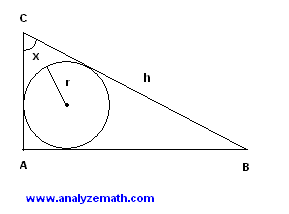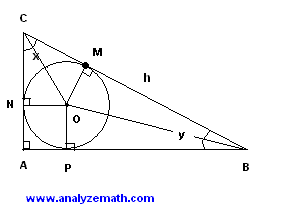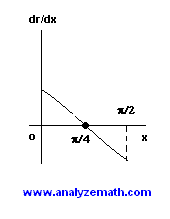Maximum Radius of Circle
Optimization Problem with Solution
Use the derivative to find the size of an angle of a right triangle so that the radius of the circle inscribed is maximum; for a constant hypotenuse.
Problem
ABC is a right triangle and \(r\) is the radius of the inscribed circle.
a) Express \(r\) in terms of angle \(x\) and the length of the hypotenuse \(h\).
b) Assume that \(h\) is constant and \(x\) varies; find \(x\) for which \(r\) is maximum.

Solution to Problem:
a) Let M, N, and P be the points of tangency of the circle and the sides of the triangle. \(OM\), \(ON\), and \(OP\) are perpendicular to \(CB\), \(CA\), and \(AB\) respectively.

Triangles COM and CON are right triangles and have two congruent sides: \(CO\) and \(OM\) and \(ON\); the two triangles are therefore congruent. We denote the size of angle \(MCN\) by \(x\) and write
\[
\tan\left(\frac{x}{2}\right) = \frac{r}{CM}
\]
Triangles BOM and BOP are right triangles and have two congruent sides: \(BO\) and \(OM\) and \(OP\); the two triangles are therefore congruent. We denote the size of angle \(MBP\) by \(y\) and write
\[
\tan\left(\frac{y}{2}\right) = \frac{r}{BM}
\]
Note that
\(y + x = 90\) which gives \(y / 2 = 45 - x / 2\)
Substitute \(y / 2\) by \(45 - x / 2\) in the equation \(\tan\left(\dfrac{y}{2}\right) = \dfrac{r}{BM}\) to obtain
\[
\tan\left(45 - \frac{x}{2}\right) = \frac{r}{BM}
\]
We now solve the equation \(\tan\left(\dfrac{x}{2}\right) = \dfrac{r}{CM}\) for \(CM\) and solve the equation \(\tan\left(45 - \dfrac{x}{2}\right) = \dfrac{r}{BM}\) for \(BM\) to obtain
\(CM = \dfrac{r}{\tan\left(\dfrac{x}{2}\right)}\) and \(BM = \dfrac{r}{\tan\left(45 - \dfrac{x}{2}\right)}\)
We now use the fact that \(h = CM + BM\) to write the equation
\(h = \dfrac{r}{\tan\left(\dfrac{x}{2}\right)} + \dfrac{r}{\tan\left(45 - \dfrac{x}{2}\right)}\)
\[ = r \left[ \frac{1}{\tan\left(\frac{x}{2}\right)} + \frac{1}{\tan\left(45 - \frac{x}{2}\right)} \right] \]
We now use trigonometric identities to simplify the above equation. The first identity we will use is
\[
\tan\left(45 - \frac{x}{2}\right) = \frac{\tan(45) - \tan\left(\frac{x}{2}\right)}{1 + \tan(45)\tan\left(\frac{x}{2}\right)}
\]
\[ = \frac{1 - \tan\left(\frac{x}{2}\right)}{1 + \tan\left(\frac{x}{2}\right)} \]
The formula for \(h\) is now given by
\[
h = r \left[ \frac{1}{\tan\left(\frac{x}{2}\right)} + \frac{1 - \tan\left(\frac{x}{2}\right)}{1 + \tan\left(\frac{x}{2}\right)} \right]
\]
We now use the identity \(\tan\left(\dfrac{x}{2}\right) = \dfrac{\sin\left(\dfrac{x}{2}\right)}{\cos\left(\dfrac{x}{2}\right)}\) and other identities to rewrite \(h\) as follows
\[ h = r \left[ \frac{\cos\left(\frac{x}{2}\right)}{\sin\left(\frac{x}{2}\right)} + \frac{\cos\left(\frac{x}{2}\right) + \sin\left(\frac{x}{2}\right)}{\cos\left(\frac{x}{2}\right) - \sin\left(\frac{x}{2}\right)} \right] \]
\[ = r \left[ \frac{1}{\sin\left(\frac{x}{2}\right) (\cos\left(\frac{x}{2}\right) - \sin\left(\frac{x}{2}\right))} \right] \]
We now solve the above equation
for \(r\) to obtain
\[ r = h \sin\left(\frac{x}{2}\right) (\cos\left(\frac{x}{2}\right) - \sin\left(\frac{x}{2}\right)) = h (\sin\left(\frac{x}{2}\right) \cos\left(\frac{x}{2}\right) - \sin^2\left(\frac{x}{2}\right)) \]
We now use the identities \(\sin\left(\dfrac{x}{2}\right)\cos\left(\dfrac{x}{2}\right) = \dfrac{1}{2} \sin (x)\) and \(\sin^2\left(\dfrac{x}{2}\right) = \dfrac{1}{2} - \dfrac{1}{2}\cos(x)\) to write \(r\) as follows
\[ r = \frac{h}{2} (\sin(x) + \cos(x) - 1) \]
b) Now that we have calculated \(r\) as a function of \(x\), and \(h\) assumed constant, let us find the first derivative of \(r\) with respect to \(x\)
\[ \frac{dr}{dx} = \frac{h}{2} (\cos(x) - \sin(x)) \]
Let us find a critical point for \(r\) by solving the equation \(\dfrac{dr}{dx} = 0\).
\[ \frac{h}{2} (\cos(x) - \sin(x)) = 0 \]
gives
\[ \cos(x) - \sin(x) = 0 \] since \(h\) is constant and not equal to 0.
\[ \cos(x) = \sin(x) \]
Square both sides
\[ \cos^2(x) = \sin^2(x) \]
\[ \cos^2(x) = 1 - \cos^2(x) \]
Solve for \(\cos(x)\) to obtain
\[ \cos(x) = \pm \frac{1}{\sqrt{2}} \text{ or } - \frac{1}{\sqrt{2}} \]
\(x\) is an acute angle and therefore the solution to our equation is given by
\[ x = \frac{\pi}{4} = 45^\circ \]
The graph of \(\dfrac{dr}{dx}\) is shown below and \(\dfrac{dr}{dx}\) is positive for \(x \lt \dfrac{\pi}{4}\) and negative for \(x > \dfrac{\pi}{4}\), therefore \(r\) has a maximum at \(x = \dfrac{\pi}{4} = 45^\circ\).

\(x = 45^\circ\) is the value of angle \(ACB\) for which the radius \(r\) is maximum for a given value \(h\) of the length of the hypotenuse. Note that in this case triangle ABC is isosceles.
More references and Links
calculus problems



